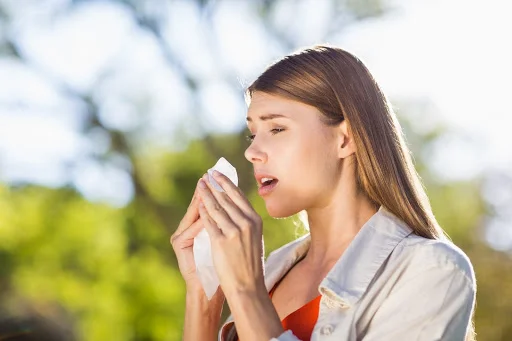If you’ve used our patches for a while now, you’re probably the kind of person who prefers to take charge of your health. You firmly believe that there are better, healthier ways to live, and you’re willing to go out on a limb to try them.
Except in one area: your allergies. Whether it’s peanuts, pollen, or the neighbor’s pet, your allergies are one area where you rely heavily on over-the-counter medicines to muscle through allergy season. But you’re getting tired of being drowsy all the time or feeling like your allergy medicine only does so much.
What if we said there are other options out there?
If you’re tired of relying on harsh drugs and are ready to try something new, natural remedies for allergies may be the answer. Here’s what you need to know to select the best medicine for allergies.
What Causes Allergies?
Quick question: what causes allergies?
If you’re like most people, you’re quick to blame annual pollen or your best friend’s cat as the culprit. But remember–these things are perfectly harmless to most people. They aren’t the cause of allergies.
The real culprit is internal: your immune system.
The immune system is responsible for keeping you healthy by protecting your body against pathogens. Let’s say, for example, that you get the flu. While you’re sick, the immune system raises your body temperature to try to overheat the virus and, in the meantime, checks B-lymphocytes to see if it has encountered this pathogen before and how to respond.
Allergies happen when your immune system reacts to otherwise harmless things like pollen as though it’s fighting off an invader to keep you healthy, even though your body doesn’t need protection.
Essentially, your immune system mistakes innocent things as a threat and attacks them, creating allergy symptoms.
How an Allergy Starts
All allergies start the same way: with exposure.
Your body encounters your trigger or allergen. It sees this allergen as a threat, even if it has encountered this allergen before and disregarded it as nonthreatening.
Now, though, your immune system sees the allergen as a hostile invader and begins making antibodies to protect you in case the same situation happens again. These antibodies will allow your body to respond faster the next time it encounters the same allergen, as it already has the road map in place to mount an immune response.
The next time your body encounters that allergen, your immune system flies into action. This time, the antibodies are already available to quickly recognize the allergen and turn on mast cells.
Mast cells set off a rapid inflammatory response, either directly killing the pathogen or bursting to release chemicals that will kill the pathogen. In this case, mast cells burst open to release histamine, causing various immune responses such as swelling.
There are two things to keep in mind with allergies: exposure and recovery.
The amount of exposure makes a difference in the level of immune response–the greater your exposure, the more severe your response. If you’re mildly allergic to dairy, for example, you may be able to eat some dairy before you start getting an allergic reaction. However, some people have severe allergies that require very little exposure to set off an immune response.
The bigger issue is recovery, as it’s impossible to predict how well you’ll recover from an allergic reaction (especially a severe allergic reaction). This separates allergies from everyday issues like the flu, as your body knows how to heal from a pathogen like a virus. Allergies require treatment to deal with an unnecessary immune response.
That said because recovery is unpredictable, the best route is to avoid your allergens altogether.
What If You Never Had Allergies?
Let’s say you never had allergies before–is it possible to get them later in life?
Yes.
Most people inherit allergies from their family–a parent is more likely to pass on an allergy to their child, and that child is more likely to have a more severe allergy than their parents. Identical twins share allergies about 70% of the time.
That said, it is entirely possible to acquire allergies later in life. This can happen for any number of reasons. Some women acquire allergies for the first time while pregnant, especially if they have a history of them. You may develop an allergy after encountering an allergen while your immune system is weakened, such as after a major virus.
Besides, many people develop allergies after moving a significant distance to a new place, as the pollen of their new area is unfamiliar to them and their body thinks it poses a threat.
Some people can even develop an allergy after severe exposure, such as developing an allergy to bee stings after being stung by dozens of bees at once.
It’s the same mystery behind why some children grow out of allergies and some don’t. Either way, it is entirely possible to develop allergies as an adult if you never had them before. The difference is that allergies acquired as an adult are more likely to stay with you.
What If You Have More Than One Allergy?
If your allergy symptoms seem to get worse over time, there may be a reason beyond simple exposure: you may have more than one allergy.
Having more than one allergy makes you more likely to develop additional allergies, as your immune system is already predisposed to overreaction.
It’s also possible to develop allergies based on similar allergens. Many people who are allergic to pollen are also allergic to certain foods that have similar proteins in them, such as fruits and vegetables. It’s also possible to have a heightened allergic reaction if you’re exposed to two similar allergens at the same time, such as if you eat a banana at the height of the ragweed season.
Common Symptoms
Allergy symptoms depend on the person and the type of allergy in question, as it depends on the substance and where exposure occurred. They can also range from mild to severe. A severe allergic reaction is known as anaphylaxis and can be life-threatening if untreated.
A food allergy, for example, can cause:
-
Tingling in the mouth
-
Swelling of the lips, tongue, face, or throat
-
Digestive upset
-
Hives
-
Anaphylaxis
Keep in mind that it depends on how severe your allergy is–some people have to eat their food allergen to get a reaction, while others have airborne allergies and can’t even be in the same room.
An insect sting allergy is a common example of a localized allergic reaction, and can include symptoms like:
-
Swelling at the sting site
-
Coughing, wheezing, shortness of breath
-
Hives and swelling all over the body
-
Anaphylaxis
However, some allergies are more subtle. A good example is a skin condition called atopic dermatitis, better known as eczema, an immune reaction protecting the skin against pathogens. Common symptoms include:
-
Dry, flaky, or peeling skin
-
Red to brownish-gray rashy patches, particularly on the hands, feet, ankles, wrists, chest, and the bend of your elbows and knees
-
Thickened, cracked, or scaly skin
-
Small raised bumps which may leak fluid when itched
However, skin allergies like eczema are unusual in that they’re typically treated with medicated topical creams rather than more common anti-allergy medications.
Current Allergy Treatments
Since allergies all have their roots in an overactive immune system, allergy treatments are all based on dealing with the immune response. Here are a few of the most common allergy treatments currently on the market.
Antihistamines
By far the most common allergy remedy is antihistamines.
Remember earlier when we said that your body reacts to an allergen by causing mast cells to burst and release histamines? Antihistamines are a type of drug that works by blocking the effects of histamines, which makes them useful in treating a variety of allergy symptoms from a runny nose to sneezing to hives.
You’ve likely heard of antihistamines before, in the form of drugs like Allegra (fexofenadine), Benadryl (diphenhydramine), and Claritin (loratadine).
Steroids
Most people associate steroids with sports scandals, but they’re useful in reducing inflammation of the nasal passages, lungs, and skin. This is why they’re often used in the form of nasal steroid or corticosteroid sprays.
Nasal steroids are particularly useful in the treatment of persistent allergy symptoms, but they may take a few days to start working. Any steroid use to treat allergies should be monitored by your doctor, as they can create side effects.
Mast Cell Stabilizers
Remember when we said that mast cells are vital in producing an immune response, and they work by bursting and releasing histamines? Mast cell stabilizers are designed to prevent that from happening.
The basic mechanism of these medications is to block the release of chemicals triggering an immune response, usually in the eyes or nasal passageways. That said, they’re designed to prevent allergies, not treat them once a reaction has already begun, so they’re given to patients with seasonal allergies two weeks before allergy season begins.
Leukotriene Modifiers
Leukotrienes are a familiar of inflammatory modifiers which play a key role in allergic reactions, particularly related to asthma. In chronic, severe asthma, general bronchial hyperreactivity is largely caused by eosinophils attracted to the bronchioles by leukotrienes.
In non-scientist English, leukotrienes are a key player in acute asthma attacks and long-term sensitivity.
Leukotriene modifiers block the actions of leukotrienes, thus treating airway constriction, inflammation of the lungs, and increased mucus production behind asthma attacks.
Epinephrine
At the far end of the spectrum is epinephrine, which is used to treat anaphylaxis until emergency treatment can be administered by paramedics and emergency room staff.
If you know a bit about science and human biology, you know that humans have our own naturally-occurring supply of epinephrine–it’s a neurotransmitter and hormone in our bodies. But you probably know it by its other name: adrenaline.
Epinephrine is the key ingredient in EpiPen and AdrenaClick, pre-filled auto-injectors that quickly deliver epinephrine under the skin or into the muscles of the outer thigh. It’s part of a class of drugs called vasopressors, which relax the airways and tighten the blood vessels.
An epinephrine injection works quickly to stimulate the heart, raise dropping blood pressure, reverse hives, and reduce swelling. Because of this, it’s also used in emergencies known as asystole, when the heart stops beating.
To be clear: epinephrine is not a treatment for allergies, but rather a short-term stabilizer to counteract the effects of anaphylaxis and give you enough time to get to a hospital where emergency staff can administer treatment.
Before Trying Natural Remedies
Now that you know a bit about how allergies work and how common allergy remedies work to counteract them, a word about natural remedies. Before you try natural allergy relief, always be aware of the following. Talk to Your Doctor
Before you try alternative allergy relief, always talk to your doctor first.
That’s because you need to be aware of the risk attached to your allergy and what an allergy medicine would have to treat. If you’re considering switching off of common allergy treatments in favor of natural remedies, you should also talk to your doctor about any underlying allergies you have that might change how you respond to natural allergy treatment.
This is especially important if you have multiple allergies, as you need to account for the effects of each allergy and its severity.
The safest and most comprehensive way to check your allergies is to have your doctor administer a skin test, which can help confirm whether a particular substance you eat, breathe, or touch is causing allergic symptoms.
During a skin test, your skin (or a sample of skin cells sent to a lab) is exposed to a variety of known or suspected allergens. This can be done as a skin prick test, a patch test, or an injection test. A skin prick test alone can test for as many as 40 different substances at once, and any of the three tests can cover allergens you would never think of, such as preservatives, metals, and resins.
That said, your doctor may not elect to administer a skin test if you’ve had a severe allergic reaction in the past, so talk to them about your options to test for potential allergies.
Be Aware of the Severity of Your Allergy
It’s also vital to be aware of the severity of your allergy before pursuing at-home allergy remedies.
If your allergy is severe, you’re generally advised against natural remedies for your safety. You don’t want to be caught unprepared for a severe or life-threatening allergic reaction. Barring a few exceptions, pharmaceuticals are safer and more effective, but some people do have reservations about their side effects (Benadryl, for example, is known to cause drowsiness).
If your allergy does allow some wiggle room to experiment with other options without serious risk to your health, you can try other remedies with your doctor’s supervision. But always keep backup allergy medication on hand in case natural remedies don’t work.
Again, don’t get caught unprepared.
The Best Natural Remedies for Allergies
With that in mind, let’s talk about the best natural remedies for allergies.
If you’re figuring out how to get rid of allergies, your goal is always the same: to lessen or block the immune response, to mitigate the effects of a reaction, or to prevent a reaction from happening in the first place. As such, the home remedies on this list all have a similar basic premise as the pharmaceutical allergy medicines listed above.
If you live in an urban area, look for a naturopathic physician, herbalist, or other experts in integrative medicine to help guide you. Otherwise, look to the Internet, but be wary of the quality and always make sure to check your sources to make sure you know exactly what’s in the remedy before you buy it.
Butterbur
Butterbur has been described as the Singular of the natural remedy world. It’s among the best-researched remedy on this list, with studies performed under the auspices of the National Institutes of Health.
It’s a shrub that grows in Europe and some parts of North America and Asia, usually marshy areas. It gets its name from its original use–wrapping butter with the leaves.
Butterbur has been endorsed by the American Academy of Neurology and the American Headache Society as a treatment reducing the frequency of migraines. It has been shown to have a similar effect to cetirizine in the treatment of allergic rhinitis (hay fever) and was as well-tolerated as cetirizine. So give it a try as a hay fever treatment.
However, studies of butterbur against Allegra have not shown it to have any significant effect on the histamine response, so it is not recommended for allergic skin reactions or asthma.
If you’re buying butterbur, never buy unprocessed butterbur, as the raw plant contains pyrrolizidine alkaloids (known to cause liver damage and can result in serious illness). Also, be aware that it may cause allergic reactions in people allergic to ragweed, chrysanthemums, marigolds, and daisies.
Quercetin
Quercetin is a type of natural bioflavonoid, a plant-derived compound often cited for its antioxidant effects. In this case, it can work as a mast cell stabilizer.
One study from Tufts University examining quercetin and cromolyn (a common mast cell stabilizer) found that quercetin was more effective than cromolyn. It was also effective in decreasing contact dermatitis and photosensitivity, skin conditions that do not respond to conventional treatment.
Also, unlike cromolyn, which must be added with the allergen or it rapidly loses effectiveness, quercetin is effective prophylactically, which means it can be taken in advance to prevent an allergic reaction from happening.
Local Raw Honey
Local raw honey is a commonly-cited anecdotal remedy for mild pollen allergies, but it is a popular pollen allergy treatment (it’s also easy to acquire, as long as you have access to a farmer’s market selling local honey).
The basic theory behind local raw honey is that because it’s made from local pollen, it can help your body gradually adjust to the pollen of your local area, thus reducing your body’s immune response over time. It’s done as a sort of allergy shot.
The good news is that unless you have a severe allergy, it doesn’t appear to have a downside.
Most people consume a teaspoon a day of raw honey, made as close to where you live as possible. It’s generally recommended to do this a month or so before allergy season begins to give your body time to adjust.
The good news about honey is that it doesn’t go bad, so unless you use honey in everything, a single jar can get you a great deal of mileage.
Nettle Tea
Another popular herbal remedy for allergies is stinging nettle, which has been used for medicinal purposes as far back as ancient Greece, where it was used as a diuretic and laxative.
The plant itself contains vitamin K, carotene, and our old friend quercetin. It’s often cited anecdotally as a means to naturally block the release of histamines, thus blocking an allergic reaction. One study did find positive effects from nettle in the treatment of allergic rhinitis, though further research is needed to establish its efficacy.
If you do elect to try nettle, make sure to buy extracts of the leaf (Urtica dioica) rather than the root (the root is used to treat prostate problems).
Looking for Natural Allergy Relief?
Whether it’s natural remedies for allergies or basic health boosts, we firmly believe that you can live a healthier life. That’s why we’re here, providing products to support the life you want to live.
If you’re having trouble during allergy season, make sure to check out our Allergy Plus Topical Patch, or check out all of our other products for a comprehensive approach to health and wellness.
And remember: your health is yours to define. Let’s take back control of your allergies and your life.









Leave A Comment
You must be logged in to post a comment.